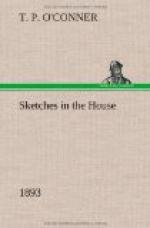CHAPTER XVI.
REDUCED MAJORITIES.
[Sidenote: The week before.]
On Friday, July 7th, we just entered on the fringe of the ninth clause. The ninth clause had all along been held to be, perhaps, the very gravest rock ahead of the Government. This is the clause which regulates the position of the Irish members at Westminster after Home Rule has been passed. There were as many plans for settling this question as there were members of the House of Commons, and all plans were alike in being illogical, unsymmetrical, and, therefore, liable to attack from a dozen different quarters. Already within a few days of each other, there had been two divisions, on which everybody felt it to be quite possible that the Government would go down, and that we should once more go back face to face with the country and probably with a new and a stronger Tory Government than ever. The first occasion was the clause dealing with a Second Chamber. Then a certain number of irreconcilable Radicals, in their hatred of all Second Chambers, voted against the Government and reduced their majority to 15. This was a very tight squeeze; but, after all, everybody had been prepared for it, and when the hour came, we all knew pretty well where we should be. There might be one or two men more or less in the Tory lobby, but we had sized them up carefully. When, however, July 19th, and the ninth clause came we were face to face with a very different state of affairs. Then we had to face absolute uncertainty—and uncertainty not in one, but almost every part of the House. And the curious thing about it all was, that this uncertainty was aggravated by a little fact which had entered into nobody’s calculations, and this was the highly technical rule with regard to the manner in which questions are put when the House is in committee.
[Sidenote: Technicalities.]
I despair of ever being able to make this matter clear to an outsider; and, indeed, to be quite honest, I am not always sure that I understand the affair myself. It will probably be sufficient for my purpose if I say that the chairman has to put an amendment in such a way that sometimes you find you are really precluded from voting on the direct question which you wish to challenge. You are within the ring-fence of a technical rule, which compels you to fight your issue there and not one inch outside of it. This often means that questions are raised in the most indirect way—that you seem to be voting for one thing while you really mean another, and that if you do not vote that way, you cannot vote any other. So it happened on this occasion. And we drifted about for the best way of raising the question of the presence of the Irish members, and the Government were for a while in a state of absolute and painful uncertainty. Then came one of those desultory conversations on points of order, in which so large a body as the House of Commons cannot shine—one man suggesting one method, one man another; half-a-dozen different methods proposed in as many minutes by half-a-dozen different members.




